People always surprise me when they ask why I prefer growing evergreen shrubs in my garden. The answer is so obvious! They are green, gold, or silver throughout the year.
Their branches are full of thick, elegant foliage, and their magnificent blooming makes my day during summers. Plus, these plants don’t require too much maintenance and grow successfully even on the rocky parts of my garden.
Best Evergreen Shrubs for Your Garden
1. Camellia

Within the family Theaceae, there are 260 species of the Camellia genus and 3.000 hybrids. Nowadays, gardeners throughout the world grow over 20.000 different ornamental varieties with gorgeous white, yellow, pink, and red simple or full-blown flowers and glossy deep green foliage.
This fantastic 6 and 12 feet (1.8 – 3.6 m) tall shade-loving evergreen shrub originated from the Himalayas, China, Indonesia, South Korea, and Japan. There is evidence that this plant was cultivated in these areas for more than 5000 years ago.
The first Camellia arrived in England in the 1730s, and most nurseries in France, Belgium, Germany, Italy, Holland, Spain, and Portugal were growing this exotic plant by the 19th-century. Very soon, they were spreading in the Americas, Australia, and New Zealand.
Camellia is easy to grow. Except for a few exceptions, most varieties thrive in part shade. Keep in mind that white varieties prefer shade while red-flowered varieties can tolerate even full sun.
They bloom in early spring, late autumn, or winter, at the time when little other flowers can. Once you plant this magnificent shrub, you will get a living decoration for your garden in the next hundred years. Weird, ha?
2. Mahonia

There are about 70 species of these up to 5 feet (1.5 m) tall evergreen shrubs originating from the Himalaya, eastern Asia, and the Americas.
Many gardeners beautify their gardens with these shrubs well-known for their yellow flowers in racemes. They are 2 to 8 inches (5 – 20 cm) long and bloom in late winter and the beginning of spring when attracting hummingbirds, bees, and other pollinators to your yard.
You will undoubtedly enjoy their 4 to 20 inches (10 – 51 cm) long ornamental, glossy, pinnate foliage with 5 to 15 leaflets. Moreover, they will produce exotic, edible, sometimes tart, blue-black berries, which you will adore.
It is a popular shrub since it requires low-maintenance and offers too much beauty. The only issue you may have with this evergreen shrub is quite sharp foliage, which can hurt you if you are not careful enough.
3. Yucca
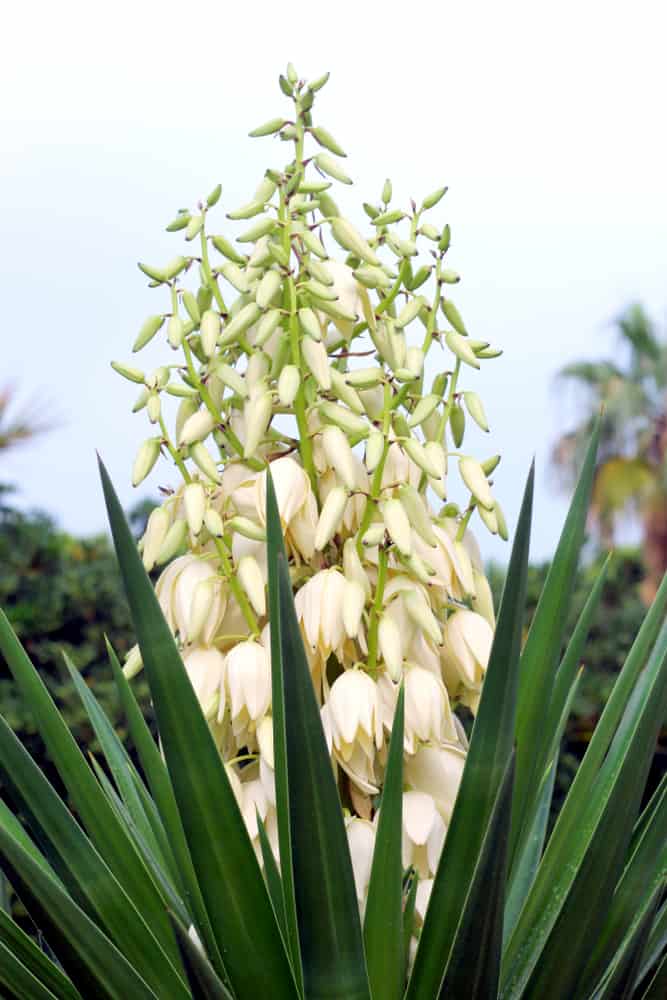
According to estimates, there are about 40 to 50 species of this perennial evergreen shrub from the family Asparagaceae. These plants, which are native to the Caribbean and Americas, are recognizable by rosettes of sword-shaped foliage and large centrally positioned panicles of white blooms.
Commonly grown in rural graveyards in past centuries, these 1 to 2 feet (30.5 – 61 cm) high shrubs are an unavoidable part of many contemporary gardens nowadays.
The great thing is that Yucca is highly resistant to almost everything, and it is green throughout the year. Plus, you can divide its roots every few years and spread the plant around or share it with neighbors.
Believe it or not, you can use this plant to treat skin and wounds or to incorporate it into your diet since it has a lot of health benefits. Full of vitamin C and antioxidants, you can use Yucca to boost your immunity, regulate blood sugar, and relieve symptoms of arthritis.
4. Holly
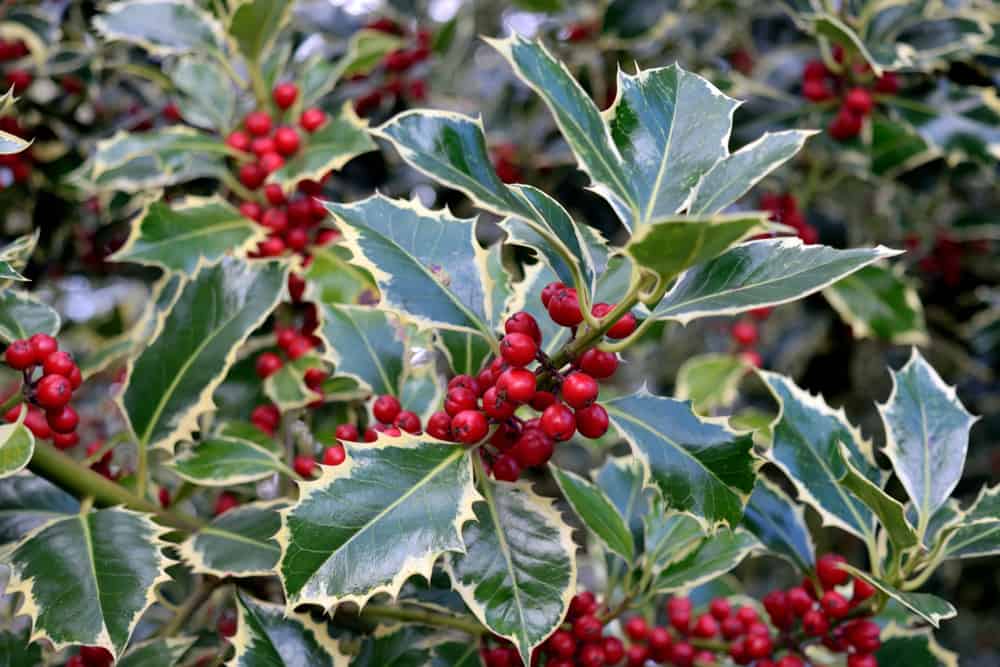
In average, there are about 600 species of shrubs in the Aquifoliaceae family worldwide. Some of them are highly popular as ornamental shrubs thanks to red or black fruits often used as Christmas decorations.
Their thick, distinctive glossy, deep dark-green leathery foliage with a light yellow-green bottom side can remain for approximately three years on the tree. That makes Holly the only one evergreen, but a non-coniferous tree in Europe.
This shrub will form 24 to 36 inches (61 cm – 0.9 m) high central stem with side-branches. There are also a lot of tiny twigs with 0.08 to 0.1 inches (2 – 3 mm) long buds at the tip and their sides.
If you want to make a natural hedge around your yard, this plant is an excellent choice for that purpose. Its flowers attract bees in spring, and the berries are an excellent source of food for birds during winter.
5. Azalea
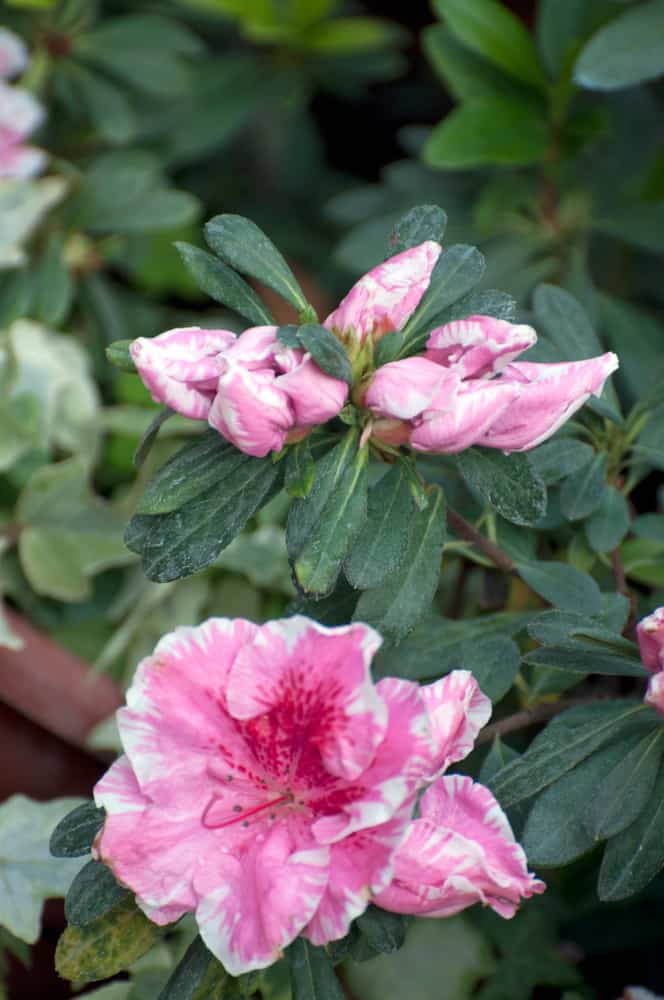
Most gardeners choose at least an evergreen Azalea shrub from the family Ericaceae for their garden. The bushes are approximately 2 to 2.5 feet (61 – 76 cm) tall. If you prune them regularly after flowering, you will get attractive rounded shapes with beautiful spring flowers.
Plus, this evergreen beauty will offer you attractive clusters of vibrant white, peach, pink, coral, or purple blooms from May to June.
On the other hand, you can expect glossy green decorative leaves become deep red in winter. Be careful since the foliage is highly toxic if ingested.
However, if you prefer a natural hedge around your yard or along a walkway, you should choose this plant. It is enough to provide dappled shade in that area and protect your bushes from harsh winds. In that case, your plant will flourish for several weeks.
Once upon a time, receiving a bouquet of these blooms in a black vase was a terrifying threat of death. Nowadays, this plant is the symbols of the Brazilian city of São Paulo and has its own festivals taking place in Japan, Korea, Hong Kong, and the US.
I am very proud that Houston, Texas was proclaimed an ‘azalea city’ by the Azalea Society of America. Every spring since 1935, the River Oaks Garden Club from this city organizes the exciting ‘Houston Azalea Trail.’ Join us!
6. Cherry laurel

One thing is certain. Cherry laurel is a favorite evergreen shrub in the region of Philadelphia, but you can grow it if you live anywhere between southern North Carolina and east Texas.
If you live in the Northern States, you can expect to face dieback of smaller branches during the winter, especially if your plant is exposed to severe winds.
This pest-resistant shrub is a species of cherry, originated from southeastern Europe and southwestern Asia. It grows best in warm regions with high humidity.
This evergreen, 15 feet (4.6 m) tall plant is one of the favorite shrubs for gardens mostly because of its gorgeous 0.5 inches (1.3 cm) long, egg-shaped red berries. Don’t eat the dark, shiny, evergreen foliage. It is poisonous despite the seductive fragrance of almond you will adore.
You will also love its flower buds appearing in early spring. Every raceme contains approximately 30 to 40 lovely, white fragrant flowers, which are up to 0.5 inches (1.3 cm) across and bloom between February and April.
7. Mugo pine
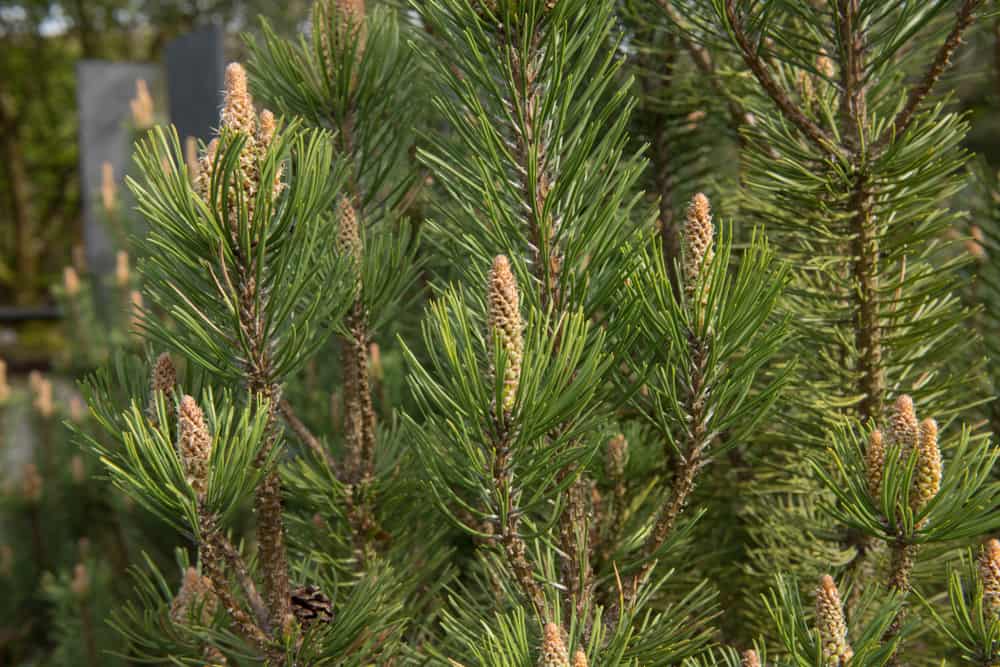
The Mugo pine is a needled, non-flowering evergreen from the family Pinaceae. This shrub originated from the Balkan Peninsula grows as a 3 feet (0.9 m) tall, saggy bush, but it can reach even 35 feet (10 m) width.
Since they tolerate air pollution, these bushes are the ultimate choice for your garden, especially if you live in an urban area. It is incredible having an opportunity to enjoy fresh pine smell in your yard and see dark green color year-round.
If you purchase a dwarf, shrubby variety, you will get neat shrub with branches growing a few inches above the soil. Every spring, your bush will have new, light shoots with stems forming so-called ‘candles.’ You can choose to enjoy them or to shear them off to get dense growth the next season.
Grow this plant if your garden is rocky or the climate is cold in the region where you live. Just be prepared for its quite slow growth and pick out the place for your shrub carefully because it will spread out up to 10 feet (3 m) wide.
8. Boxwood
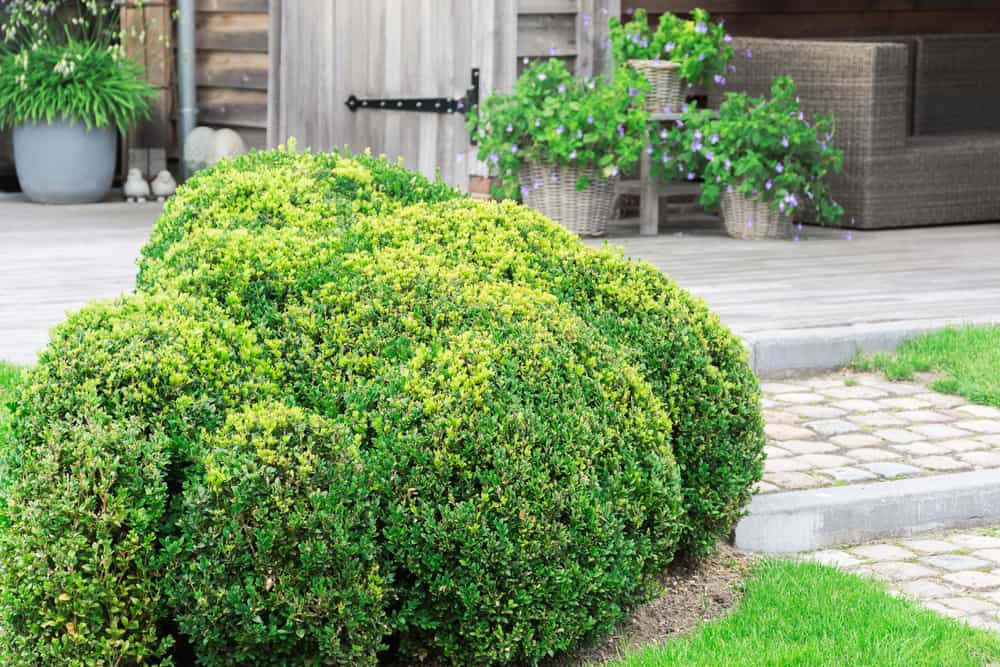
Boxwood (Buxus, box) is a 24 to 48 inches (61 cm – 1.2 m) tall broadleaf evergreen plant perfect for pruning and shaping. Therefore, you can plant this shrub as a formal hedge, topiary, and border. However, leaving it to grow in its natural shape can also be quite interesting.
That giant green ‘meatball’ from the family Buxaceae has beautiful, tiny-rounded or lance-shaped foliage which will maintain bright green color year-round. Plus, you will enjoy its gentle, yellow-green flowers which will bloom every spring.
If you have at least a partly shady garden, the only thing you need to provide is well-protected space. That way, you will keep your bush away from severe wind during winter.
Carefully choose the type of boxwood for your garden since its size, hardiness, and growth rate may vary considerably depending on particular species. Be careful since this plant contains an alkaloid toxic to pets and children. Plus, the sap may irritate the skin.
9. Rosemary
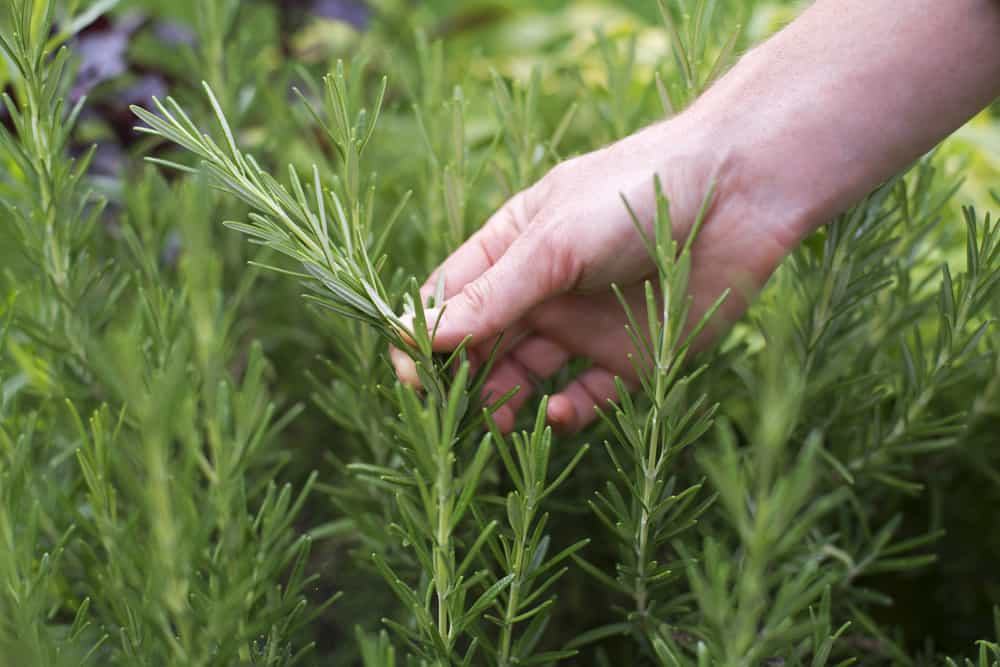
This fragrant evergreen shrub from family Lamiaceae originated from the Mediterranean. Its oil is a valuable ingredient in the perfume industry, and the herb itself is considered a spice with numerous health benefits.
Traditionally, people use rosemary to boost the immune system, improve memory, and alleviate pain in muscles.
You won’t go wrong if planting this woody, perennial herb in your yard. Its fragrant, needle-like foliage and flowers, which can be white, blue, pink, or purple, will beautify your garden and bring a breath of sea near your home.
It is not a pure coincident. The name of this plant is a literal translation of the Latin term ‘Ros Marinus’ meaning – Dew of the sea. You can expect your shrub reach approximately 3 to 5 feet (0.9 – 1.5 m) in height, depending on the climate in the region where you live.
You will have one more benefit if you live near the sea and decide to grow this mystical plant. It is entirely tolerant of salt spray, and you can keep it in a pot on the beach.
10. Juniper

Juniper is an evergreen shrub from the Cupressaceae family with the needle-like or scale-like foliage in different colors, including dark and light green, with golden hues, or silver-blue.
Since they can be monoecious or dioecious, you can choose to purchase the female shrub with fused cones (berries).
Depending on your wishes, you can pick out one of over a hundred varieties grown in the US. They can vary between medium-sized shrubs, ground-hugging forms, and tall, pyramidal plants.
Most of these shrubs are hard and highly tolerant of drought. Plant them in a sunny place and provide well-draining soil for vigorous growth. Juniper is an ideal choice if your garden is rocky or you need help in soil retention.
Even though this shrub is just 6 inches (15 cm) tall, it spreads almost 8 feet (2.4 m) wide and may become an excellent ground cover or foundational hedge. Be careful when picking out an ideal location for this evergreen plant since its soft-textured leaves easily break up decks and walkways.
11. Mountain Laurel
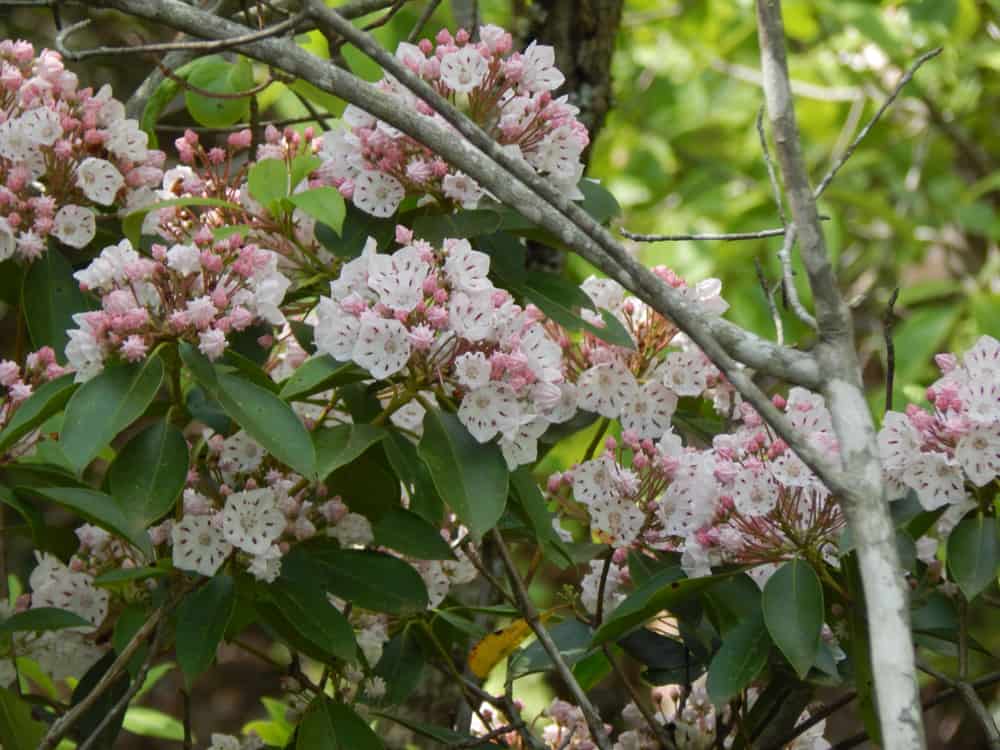
Mountain Laurel from the family Ericaceae is a 5 to 15 feet (1.5 – 4.5 m) tall evergreen shrub. Native to southern New England, it grows well from Florida to Maine. It is also the state flower of Pennsylvania and Connecticut.
Most gardeners grow this shrub because of its magnificent flowers in spring. I have to admit that I am one of them and really love those pink or deep-rose cup-shaped flowers. Their blooming time is in May or June, which primarily depends on the region you live in.
If you decide to enrich your garden with this valuable plant, pick out an appropriate place in full sun or partial shade for it. Also, you should provide fertile and well-drained soil to let your bush thrive, and to keep it moist regularly.
Summary
Once you decide to grow evergreen shrubs in your garden, you should check if it suits the USDA Hardiness Zone in the region where you live.
Make sure that the place you reserve for a particular shrub is on full-sun, part-sun, or shade, depending on the variety you want to grow.
Don’t forget to check how tall and wide your bush will be when mature to avoid unpleasant surprises. These plants may live for decades, and picking out the wrong space will be a waste of time and money.

Leave a comment